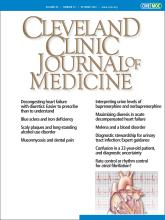Article Figures & Data
Tables
Treatment Indications Contraindications Rate control Asymptomatic atrial fibrillation and rhythm control not favored (elderly patient, long-standing atrial fibrillation, markedly enlarged left atrium) Avoid calcium channel blockers in patients with heart failure Electric cardioversion Symptomatic atrial fibrillation
New-onset atrial fibrillation
Low risk of thromboembolism: (< 48 hours since onset of atrial fibrillation, or at least 3 weeks of anticoagulation, or transesophageal echocardiography to rule out thrombus)No anticoagulation or inability to obtain transesophageal echocardiography Antiarrhythmic medications Younger patient
High cardiovascular risk
Heart failure
Failure of rate control therapyAvoid propafenone and flecainide in those with structural heart disease and coronary heart disease
Avoid dronedarone in persistent atrial fibrillation and congestive heart failure
Avoid sotalol and dofetilide in renal failureCatheter ablation Younger patients
Symptomatic atrial fibrillation, refractory to medical therapy
Can be considered in heart failureMarked left atrial dilation Atrioventricular junction ablation and cardiac resynchronization therapy Contraindication to ablation or failure of ablation
Permanent atrial fibrillation
Systolic heart failure with ejection fraction < 30%Frail patient
Expected survival < 1 year






